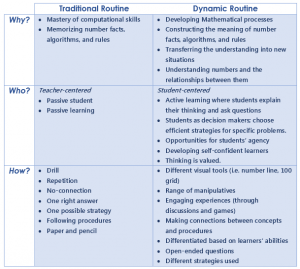
Procedural fluency is one of the five strands of mathematical proficiency: conceptual understanding, procedural fluency, strategic competence, adaptive reasoning, and productive disposition, and it is defined as the skill in carrying out procedures flexibly, accurately, efficiently, and appropriately. Knowing that these strands are interwoven and interdependent, the question is how to develop a balanced curriculum that ensures the development of these strands simultaneously. Moreover, and since the IB PYP – Math Scope and Sequence is one of the most powerful tools for implementing a concept- based Math curriculum, I was wondering how to translate it into teaching practices? What opportunities should we give the learners to construct their own procedures and make connections between the strands of proficiency? How can we make shifts in our instructional practices in order to foster sense-making in Mathematics?
Thus, the aim of this blog is to highlight one needed aspect to develop procedural fluency, Routines.
One of the know tools or activities that help learners develop procedural fluency, as well as reasoning and problem-solving skills, is Mathematics Routines. Routines are defined as a desirable way to begin math class. They develop number sense by connecting critical math concepts on a daily basis. Moreover, warm-ups are one of the components of the Balanced Numeracy Program where learners work together on a strategy or skill in order to develop the specialized knowledge and language needed for conceptual understanding and applying mathematical concepts.
However, and despite all these ideas and resources, I still have a set of burning: Are these experiences well planned in order to develop the learners’ mathematical proficiency and processes? How can we assess these experiences? What are the criteria or the key elements that guide us toward planning meaningful experiences?
Going one-step backward, the definition of computational fluency, as stated by the National Council Teachers of Mathematics, that is “Computational fluency refers to having efficient and accurate methods for computing. Students exhibit computational fluency when they demonstrate flexibility in the computational methods they choose, understand and can explain these methods and produce accurate answers efficiently. (Principles and Standards for School Mathematics States). It is a definition that highlights significant keywords: flexibility, choice, understanding, efficiently, and explain.
At this stage, and as a conclusion, I suggest transferring our routine to be Dynamic. The following table represents what I mean:

In order to apply dynamic routines, teachers must provide learners with several elements. The following are the essential ones:
- Work in a safe environment where their thinking is valued
- Build a repertoire of efficient strategies
- Make decisions about choosing efficient strategies for specific problems
- Being able to demonstrate their thinking
- Provide opportunities for metacognition
- Interact and are engaged in discussions
- Use concrete models and/or manipulatives
- Have voice and choice
- Make connections between strands
- Are confident and motivated and contribute to a positive attitude toward Math
- Explain their thinking using mathematical language and ask questions
- Develop a strong sense of mathematical identity and self-confidence
- Are risk-takers who don’t hesitate to test other’s strategies and assess their validity
In the coming blog, I will share how I trained teachers to apply dynamic routines, in addition to examples from classrooms.